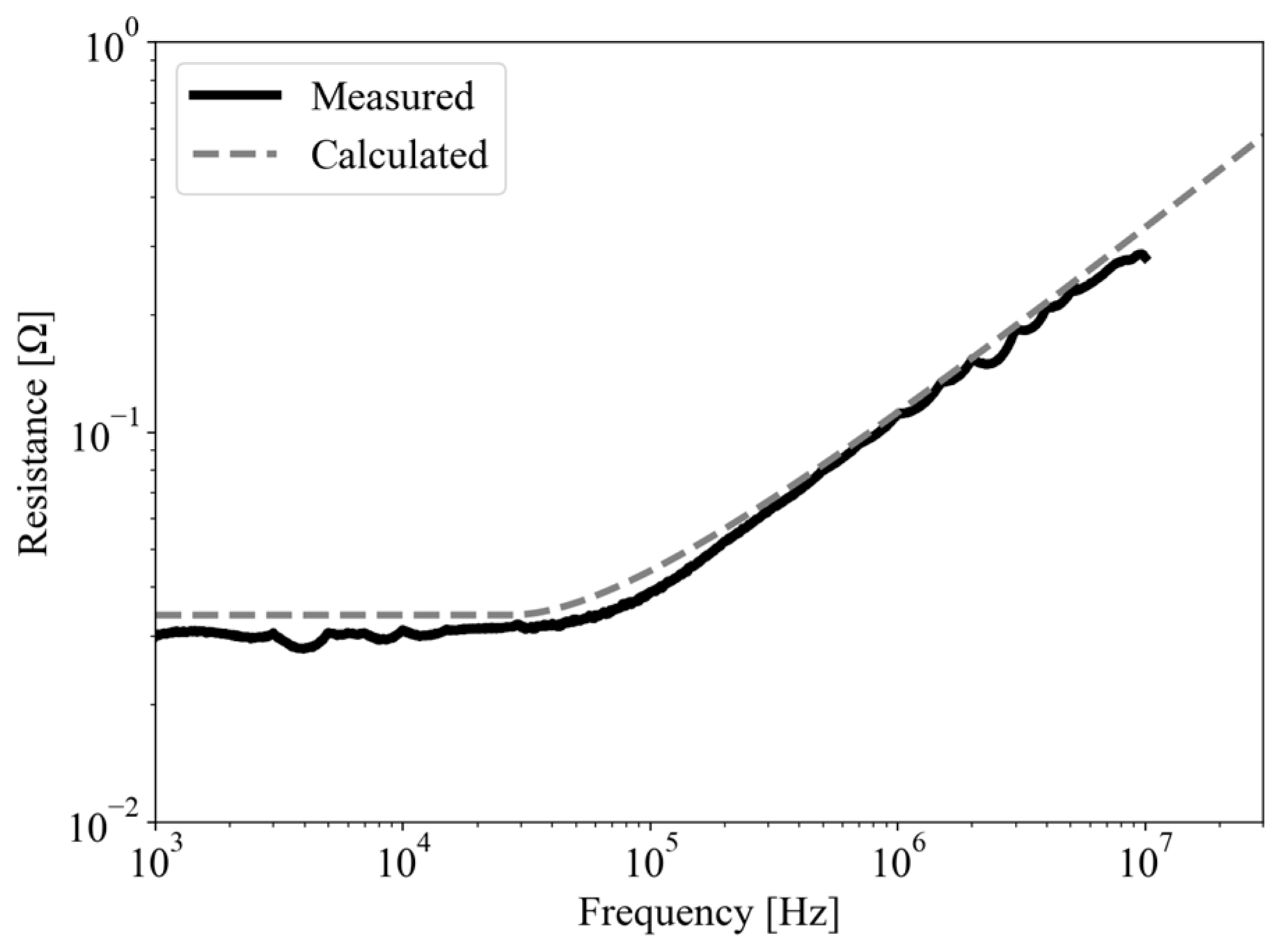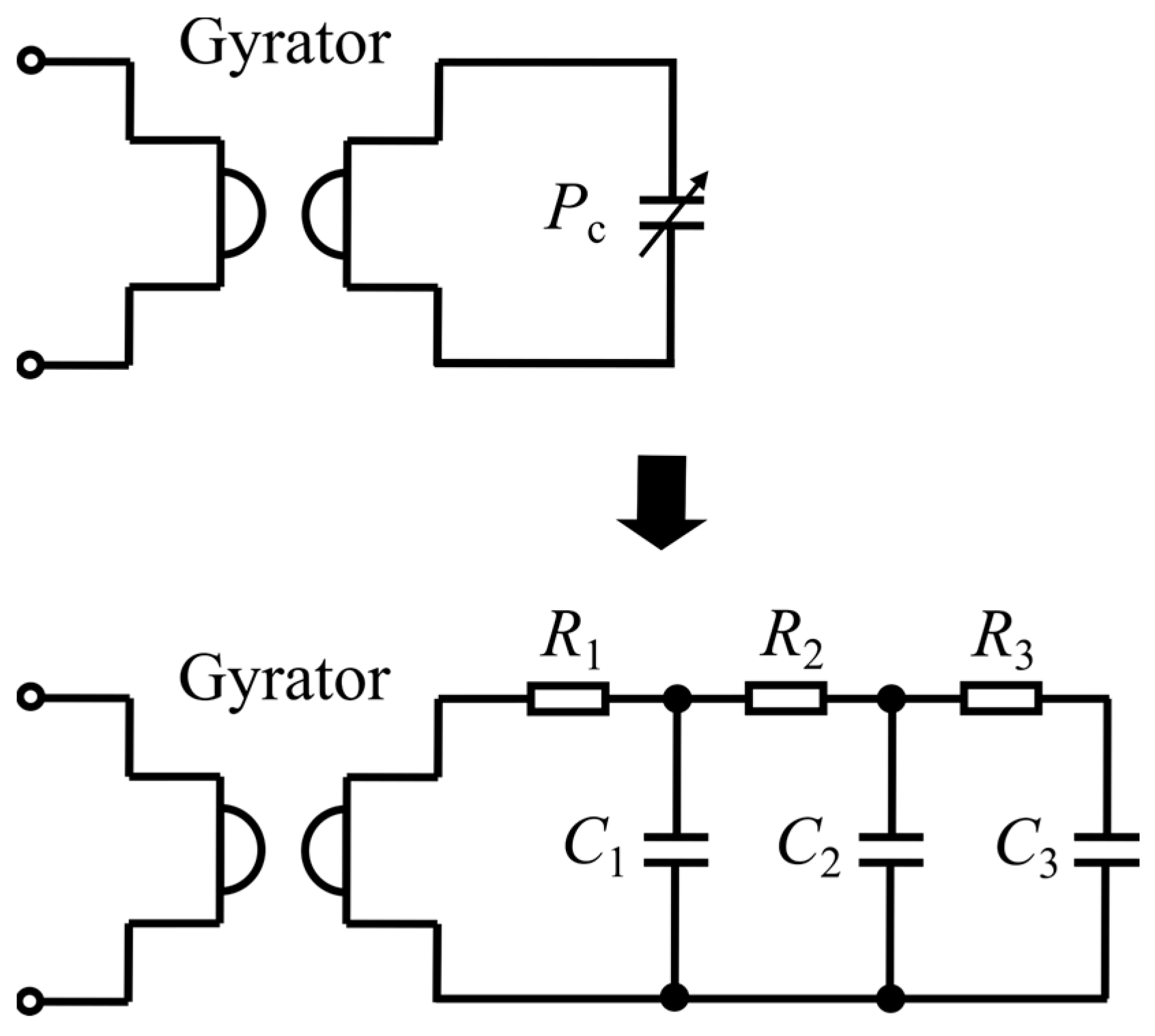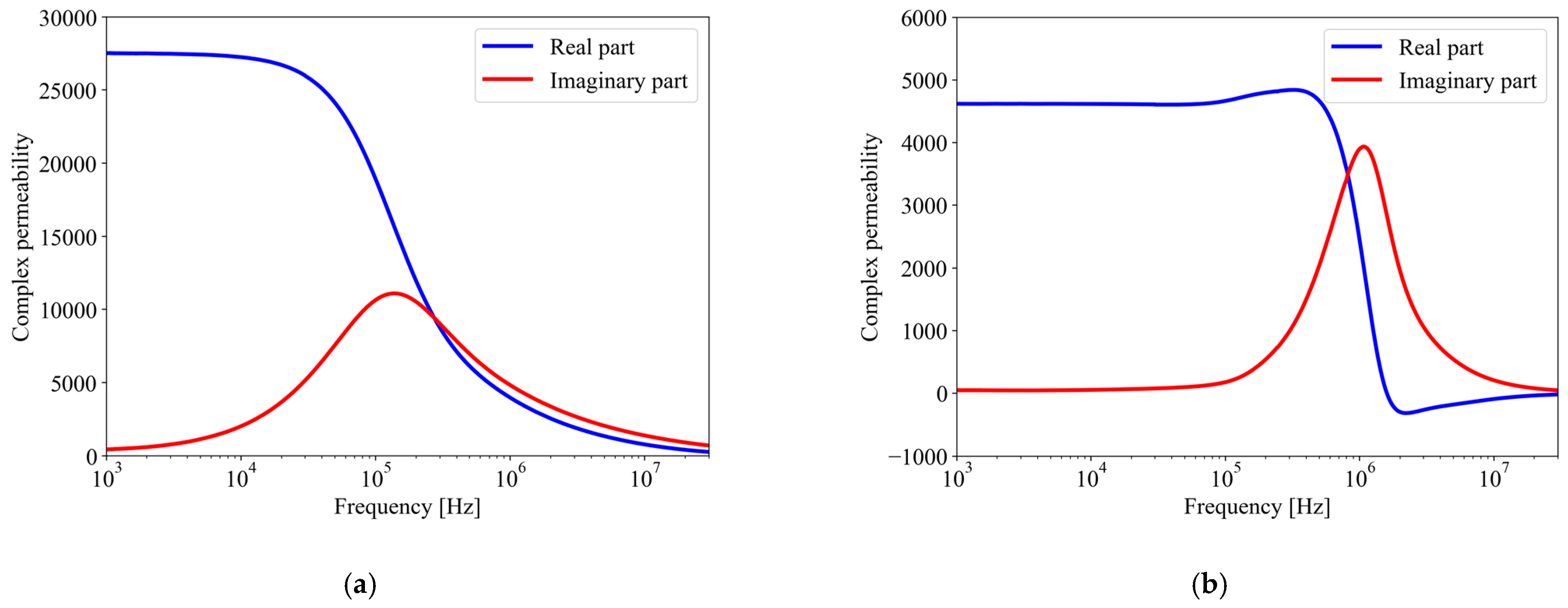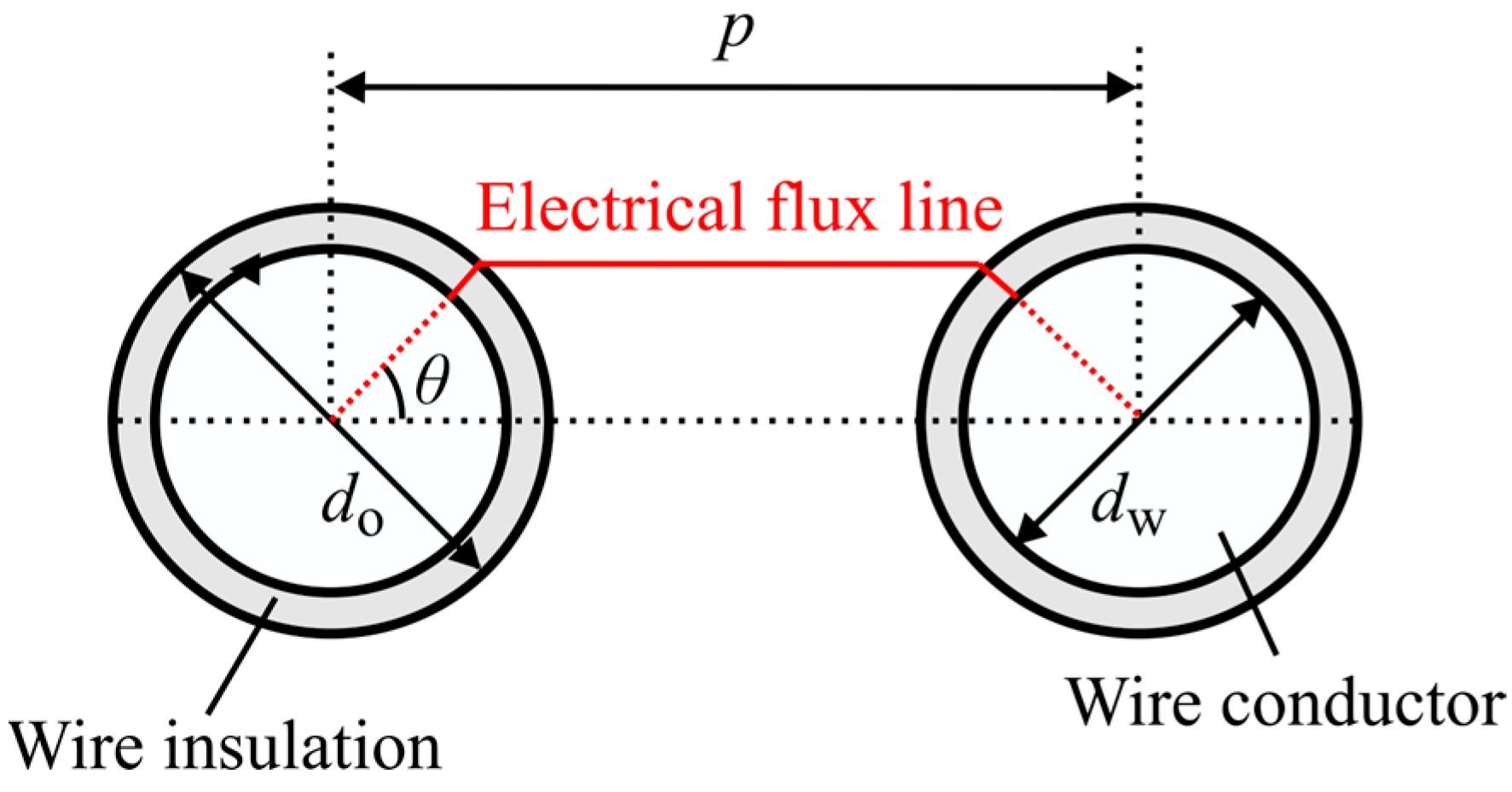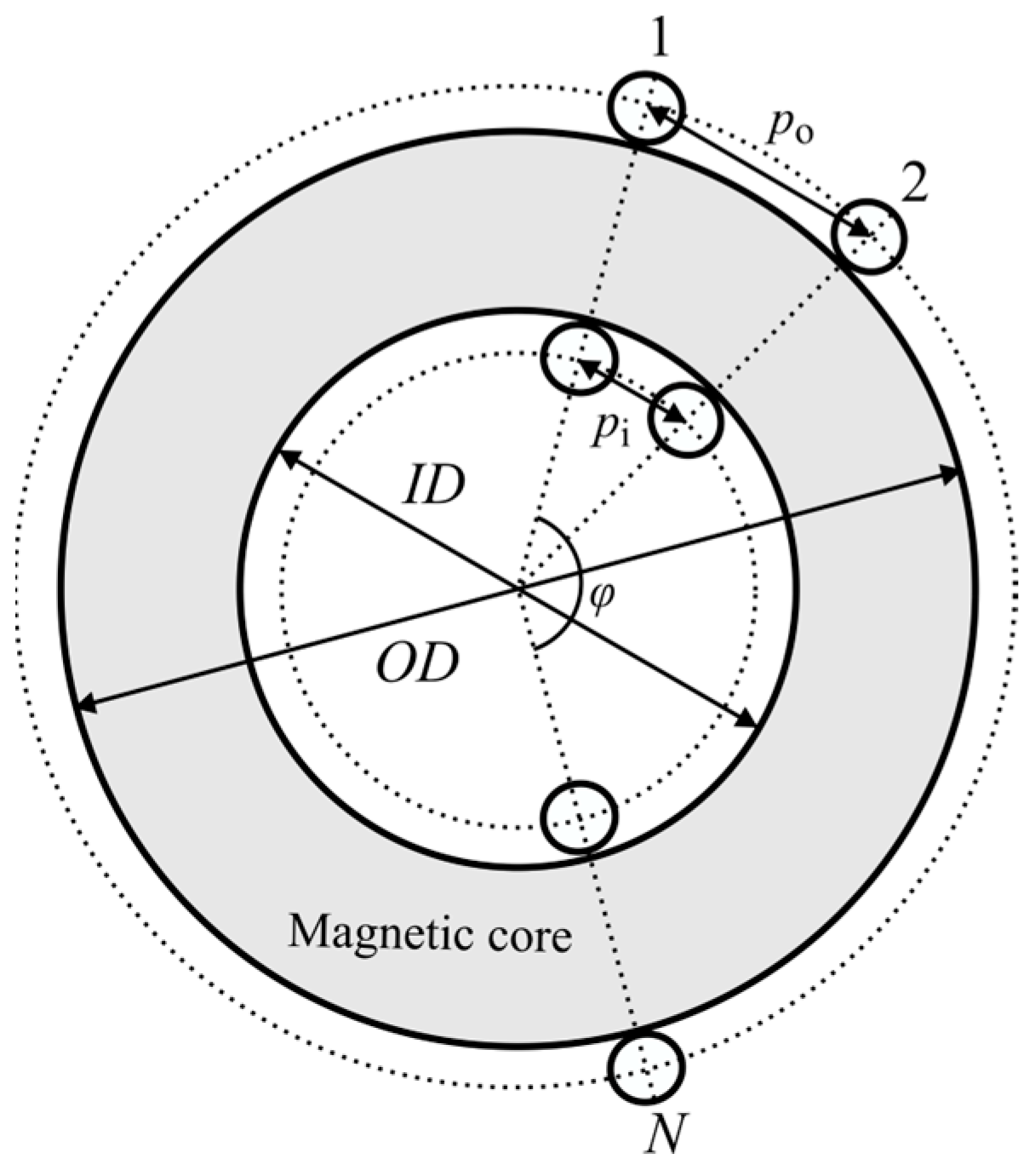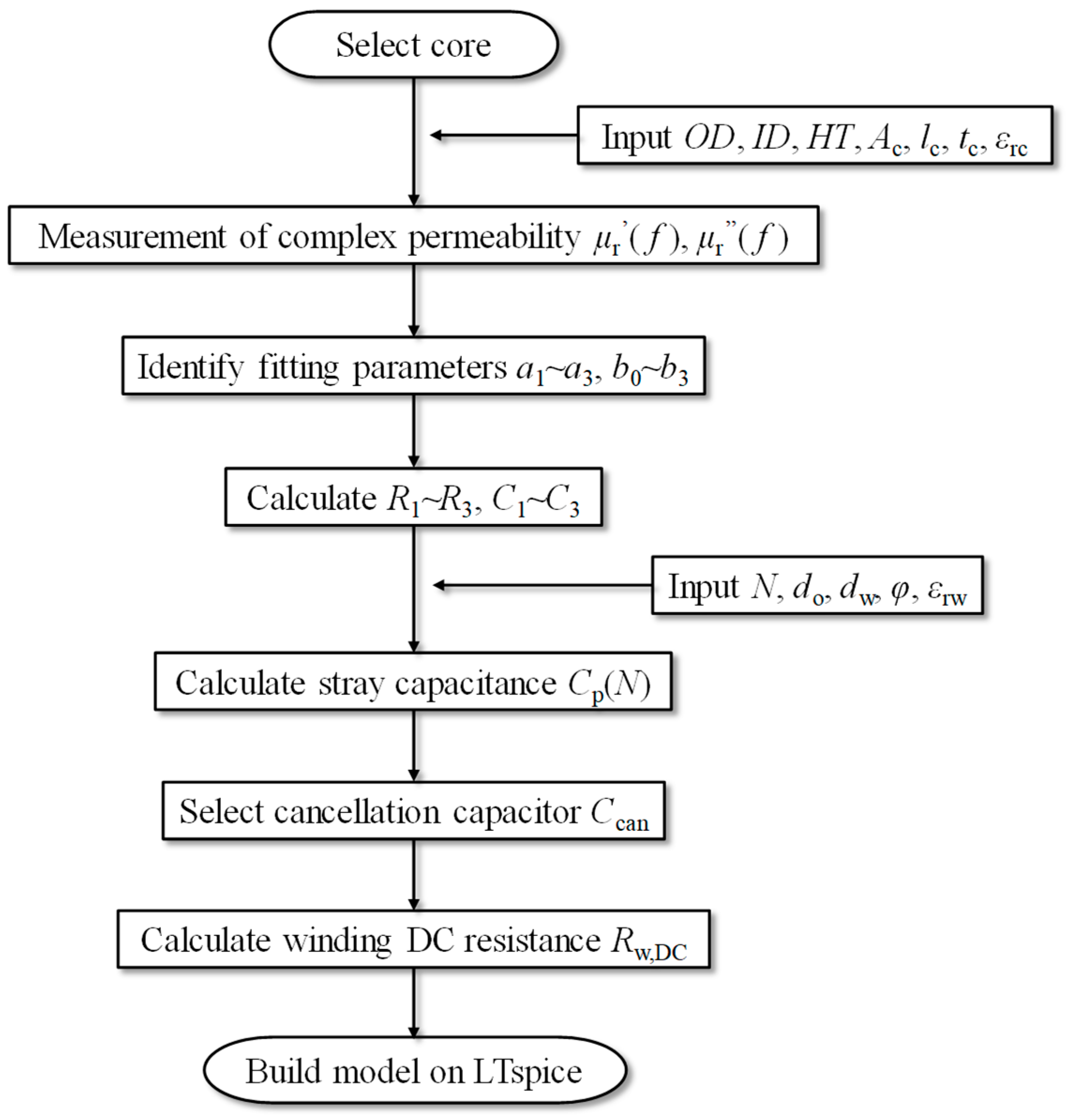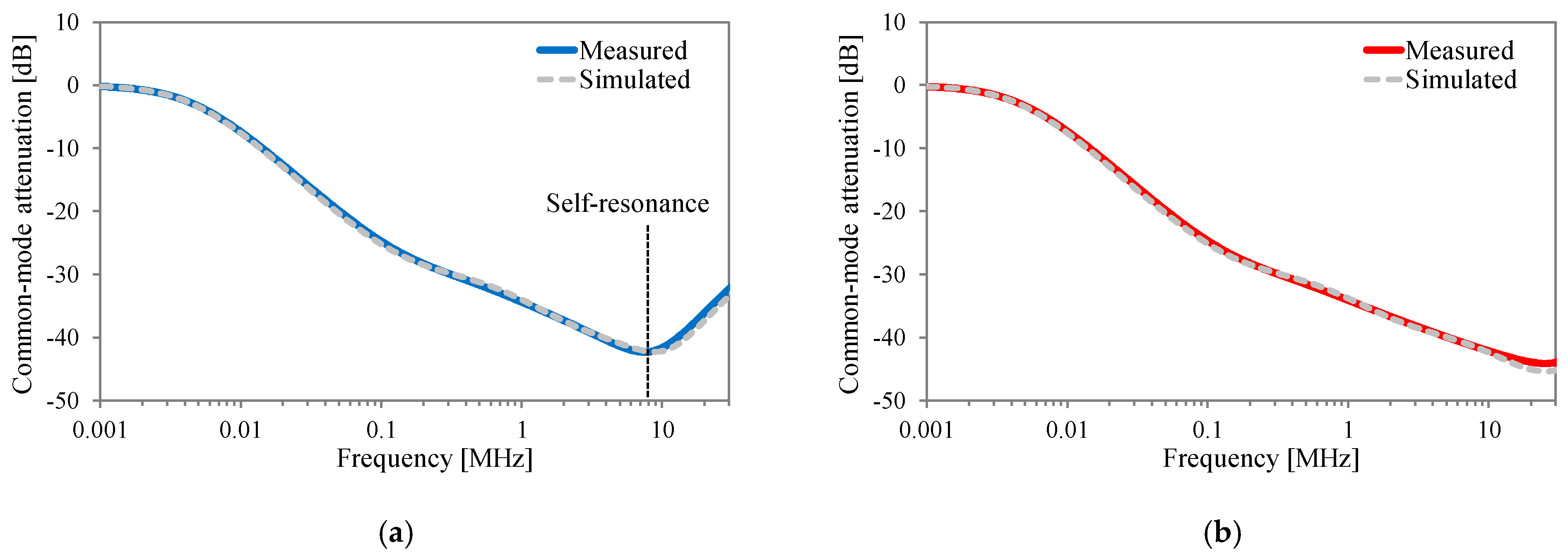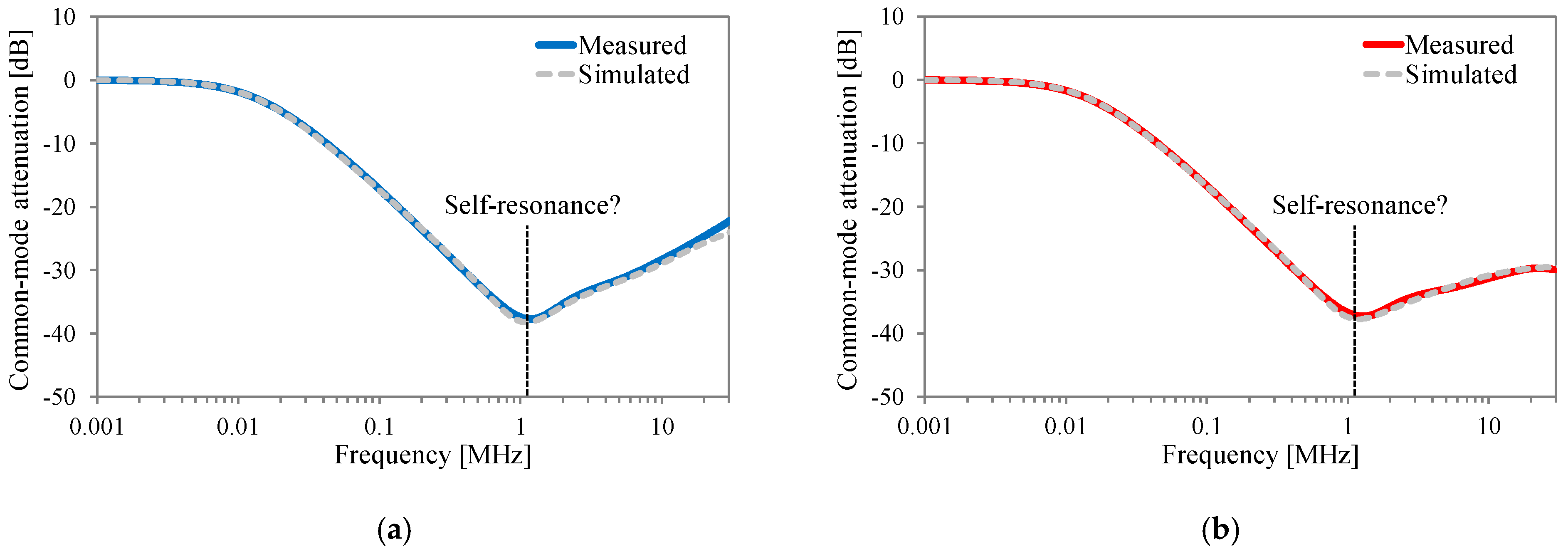1. Introduction
Lately, power semiconductor devices made from silicon carbide (SiC) have entered the market and are being utilized in numerous applications [
1,
2,
3,
4]. These SiC-based power devices can complete switching operations ten times faster than their traditional silicon-based counterparts. As a result, by enhancing the switching frequency of power converters, there is the potential to minimize the size of passive components. Conversely, the significant dv/dt and di/dt associated with SiC devices contribute to a rise in high-frequency electromagnetic interference (EMI) in power converters [
4,
5,
6,
7]. Consequently, implementing EMI filters is essential to achieve substantial noise reduction across a broad frequency range.
Common-mode inductors (CMIs) combined with Y-connected capacitors form common-mode (CM) EMI filters [
8,
9,
10]. For safety, the capacitances of Y-connected capacitors are restricted to a few nanofarads, necessitating CMIs with substantial CM inductance. Consequently, CMIs in power converters often have a larger size, weight, and cost. Typically, nanocrystalline or manganese–zinc (MnZn) ferrites are used as core materials in CMIs [
11]. Nanocrystalline materials, with their high relative permeability of around 100,000 and saturation flux density near 1.2 T, greatly aid in downsizing common-mode inductors. Hence, their usage in common-mode inductors’ magnetic cores is growing. Meanwhile, MnZn ferrites, with a relative permeability up to 10,000 and a saturation flux density between 0.3–0.5 T, offer benefits such as broad bandwidth, affordability, and versatile shaping, leading to their prevalent use in commercial common-mode inductors.
The high relative permeability of these materials allows for fewer winding turns to achieve the desired CM inductance. However, independent of winding precision, CMIs experience self-resonance due to winding stray capacitance [
12,
13,
14,
15,
16,
17], acting as capacitive impedances beyond the self-resonant frequency and weakening their high-frequency emission attenuation. Therefore, extra filter components are often needed to ensure sufficient CM noise attenuation across a wide frequency range, enlarging the EMI filter.
The capacitance cancellation (CC) method has been introduced to enhance inductors’ high-frequency attenuation [
18]. As depicted in
Figure 1, this method involves adding a center tap to an inductor
L and a cancellation capacitor
Ccan between this center tap and a reference potential. Theoretically,
Ccan neutralizes the effect of stray capacitance
Cp on the inductor’s frequency characteristic, making the inductor with the CC method act like an ideal inductor. Wang et al. applied CC to a single-phase CMI and experimentally showed that CC could boost CM emission attenuation by up to 20 dB at frequencies above 10 MHz [
18]. Heldwein et al. used the CC technique on three-phase CMIs [
19]. However, previous studies identified stray capacitances from the measured attenuation characteristics and impedances of manufactured CMIs and determined the capacitance of cancellation capacitors accordingly. To date, to the authors’ knowledge, there is a lack of circuit simulation models that can accurately simulate CMIs’ attenuation characteristics with CC applied, making it challenging to assess these characteristics during the EMI filter design phase.
In the previous work [
20], an estimating method for winding stray capacitance of single-phase toroidal inductors that considers the insulation between the winding and the magnetic core has been proposed. It has been demonstrated that the proposed method can estimate winding stray capacitance with practically acceptable accuracy. Generally, single-phase toroidal inductors are fabricated by uniformly winding an entire toroidal core. On the other hand, CMIs are usually fabricated with multiple windings, which are applied to specific areas of toroidal cores. Therefore, the winding stray capacitance depends on the angle of the windings covering the core. Therefore, the method proposed in [
20] cannot be directly applied to estimate stray capacitance of CMIs. To solve the above problem, the author has modified the equations for calculating the turn-to-turn capacitance in the estimation method proposed in [
20] to be a function of the angle of the winding covering the core and applied to single-phase CMIs [
21].
Another aspect that diminishes the high-frequency attenuation properties of CMIs is the frequency-dependent nature of the complex permeability in magnetic materials. To illustrate, in nanocrystalline materials, the imaginary component of complex permeability becomes more prominent at frequencies exceeding approximately 100 kHz. Therefore, nanocrystalline-based CMIs behave as resistive components in the high-frequency range. In addition, depending on the core dimension, the permeability of manganese–zinc (MnZn) ferrite decreases drastically around 1 MHz and indicates negative polarity [
22,
23]. This steep change in the permeability degrades the high-frequency attenuation characteristics of MnZn ferrite-based CMIs. In some previous studies, simulation models of CMIs that consider the complex permeability’s frequency dependence have been proposed [
16,
24]. However, the relationship between the frequency dependence of complex permeability and the CC method has yet to be investigated in detail.
The author introduced a circuit simulation model for CMIs, accounting for the frequency-dependent complex permeability of magnetic materials and the stray capacitances of windings [
25]. This model was validated through impedance measurements, confirming its ability to simulate the small-signal characteristics of CMIs across a broad frequency spectrum, from 1 kHz to 100 MHz. Nonetheless, as presented in [
25], the model was developed without incorporating the grounding connections of cancellation capacitors. As a result, it cannot replicate the effects of the CC method on the attenuation properties of CMIs.
In this article, the author refines the previously proposed circuit simulation model for single-phase CMIs (as described in [
25]) to assess the influence of the CC method on the small-signal behavior of CMIs. Integrating cancellation capacitors, calculated based on the anticipated stray capacitance, into this adjusted simulation model makes it feasible to predict the attenuation characteristics of a single-phase CMI utilizing the CC method during the design phase of CMIs.
Note that the small-signal characteristics of a common-mode inductor are evaluated using a network analyzer in this article. Therefore, the magnetic flux generated in the inductor during the measurement is a small signal at several mT levels. Therefore, the proposed simulation model does not include phenomena specific to large-signal excitation conditions, such as magnetic saturation and nonlinearity behavior. Furthermore, losses must be considered when installing EMI filters in power converters. On the other hand, this article aims to understand the small-signal characteristics (attenuation characteristics) of CMIs with CC method at the design stage. Therefore, an evaluation of loss characteristics of CMIs is beyond the scope of this article.
Comparing the measured and simulated small-signal characteristics of actual single-phase CMIs demonstrates that the model can accurately represent the attenuation behavior of CMIs with the CC method across a wide frequency range. Additionally, empirical findings highlight that the enhancement in attenuation achieved by applying the CC method to MnZn ferrite-based CMIs is restricted in the high-frequency domain due to the sharp variation in complex permeability.
2. Simulation Model of CMIs with the CC Method
2.1. Configuration of the Proposed Model
Figure 2 presents the layout of the suggested simulation model for single-phase CMIs. This model employs the permeance–capacitance analogy [
26,
27,
28] and represents the single-phase CMI by segmenting it into two parts: magnetic and electric circuits [
25].
In order to reproduce the physical structure of magnetic components in circuit simulation, it is necessary to separate the electric circuit part from the magnetic circuit part. The model proposed in this article applies the permeance–capacitance analogy. The reluctance–resistance analogy is the well-known method for modeling magnetic components by separating the electrical and magnetic circuit parts [
28]. The models obtained by both methods are mathematically equivalent. However, in the reluctance–resistance analogy-based model, the frequency characteristic of magnetic reluctance is simulated by a ladder circuit of electrical resistance and inductance. Electric resistance, an energy storage component, is introduced in the circuit simulator to simulate magnetic reluctance, and inductance is introduced to simulate high-frequency losses. As a result, confusion may be caused when building the model.
On the other hand, the permeance–capacitance analogy simulates magnetic permeance with capacitance and high-frequency losses by introducing resistance. In other words, the permeance–capacitance analogy-based model resolves the confusion caused by the reluctance–resistance analogy. Thus, this article employs the permeance–capacitance analogy for modeling common-mode inductors.
The complex permeance Pc of the magnetic core is implemented in the magnetic circuit part of the model, and the winding resistance Rw and the parallel stray capacitance Cp are implemented in the electric circuit part. Coupling between the magnetic and electric circuit parts is realized using a gyrator, an impedance inverting component. The gain G of the gyrator corresponds to the turn number and is set to half of the turn number (G = N/2). Furthermore, cancellation capacitors Ccan are connected between the connection point of two gyrators (the center tap of the winding) and the ground to simulate the CC method.
All parameters of the proposed model for CMIs can be determined during their design phase. It is important to note that this model does not account for the leakage inductance of windings and interwinding capacitance, as the article concentrates on the small-signal characteristics of CMIs in CM. Winding resistance notably rises in the high-frequency range due to skin effects and other reasons. Nevertheless, the equivalent core loss resistance, resulting from the imaginary component of complex permeability, often far exceeds the winding AC resistance for the small-signal characteristics of CMIs at these high frequencies. Consequently, the model disregards winding AC resistance and includes only the winding DC resistance. An analysis comparing the equivalent core loss resistance with the winding AC resistance is provided in
Appendix A.
2.2. Modeling the Complex Permeance of the Core
In the proposed model, a three-stage RC circuit in
Figure 3 replicates the magnetic core’s complex permeance. Since modeling accuracy did not change significantly when higher-order ladder circuits were used, the three-stage RC ladder circuit is selected in this article. The complex permeance implemented in the magnetic circuit part is derived from the core’s dimensions and the magnetic material’s complex permeability and is incorporated into the magnetic circuit portion of the model.
Generally, manufacturers’ datasheets do not offer comprehensive broadband frequency characteristics of complex permeability. Additionally, the complex permeability of MnZn ferrites is influenced by the core’s dimensions and significantly diminishes at high frequencies. To minimize the impact of core size, manufacturers typically provide data only for cores with smaller dimensions. Therefore, measuring the frequency characteristics of complex permeability before constructing the simulation model is advisable.
Within the frequency band where the effect of stray capacitance is minor and can be overlooked, it is possible to depict the inductor as an assembly of an equivalent series inductance
Ls and an equivalent series resistance
Rs [
26]. Consequently, the real and imaginary components of the complex permeability,
μr′ and
μr″, can be expressed by Equations (1) and (2), respectively.
Ac represents the magnetic core’s cross-sectional area, lc is the magnetic path length, Nm refers to the inductor’s turn number under measurement, and μ0 is the permeability of free space (4π × 10−7 H/m).
One can directly measure Ls and Rs with a network analyzer. Inserting these measured frequency characteristics of Ls and Rs into Equations (1) and (2) allows for calculating the complex permeability’s real and imaginary parts, respectively.
Figure 4 illustrates the measured complex permeabilities of a nanocrystalline core (Vitroperm 500F, model number: T6006-L2030-W358) and a MnZn ferrite core (N30, model number: B64290L0048X830). These measurements were conducted with a network analyzer (Bode 100, Omicron Lab, Hong Kong, China) and an impedance measurement fixture (B-WIC) across frequencies ranging from 1 kHz to 30 MHz.
Figure 4a shows that the real part of the nanocrystalline core’s complex permeability starts to decline from about 20 kHz. Beyond 300 kHz, the imaginary part surpasses the real part. Conversely,
Figure 4b shows that the real part of the MnZn ferrite’s complex permeability rapidly decreases, starting around 1 MHz, with the imaginary part displaying a resonance peak. Additionally, the real part exhibits negative polarity from approximately 1.5 MHz and gradually approaches zero. This significant alteration in the MnZn ferrite’s complex permeability substantially affects the high-frequency characteristics of filter inductors [
23].
The real and imaginary parts of complex permeability can be described by Equations (3) and (4), using the RC circuit’s real and imaginary components of complex admittance
Ym, as depicted in
Figure 3.
Using fitting parameters
a1,
a2,
a3,
b0,
b1,
b2, and
b3, the admittance
Ym can be represented as
where
s =
jω.
The real and imaginary parts of the complex permeability can be calculated by dividing Equation (5) into real and imaginary parts and substituting them into Equations (3) and (4). To identify the fitting parameters, curve fitting of the calculated results to the measured results obtained from Equations (1) and (2) is performed based on the least-squares method.
Moreover, the admittance of the three-stage RC circuit is also represented by the following Equation (6).
By comparing Equations (5) and (6), the modeling components of the complex permeance R1, R2, R3, C1, C2, and C3 can be calculated based on the identified fitting parameters.
2.3. Calculating the Winding DC Resistance
In this article, the mean length per turn of toroidal core-based inductors
lT is assumed, as shown in
Figure 5. Thus,
lT is obtained from the following Equation (7), where
OD,
ID, and
HT are the outer diameter, inner diameter, and height of the toroidal core, respectively. In addition,
do is the outer diameter of the wire, including an insulation coating.
It is commonly understood that the winding DC resistance,
Rw,DC, can be expressed by Equation (8). In this equation,
ρCu denotes the resistivity of copper,
dw represents the diameter of the conductor, and
N refers to the number of turns.
The resistivity depends on temperature
T; thus, the resistivity of copper is also given by
Here, ρCu(20 °C) is the resistivity of copper at 20 °C (1.724 × 10−8 (Ω ∙ m)), and αCu is the temperature coefficient of copper (0.00393 (1/°C)). In this article, the winding DC resistance of the winding was calculated, where T was set to the room temperature (25 °C).
3. Estimation of Stray Capacitance of Single-Phase CMIs
3.1. Turn-to-Turn Capacitance
Figure 6 illustrates that the parallel stray capacitance,
Cp, is modeled as a ladder circuit consisting of the turn-to-turn capacitance,
Ct−t, and the turn-to-core capacitance,
Ct−c [
29]. Initially, the turn-to-turn capacitance is determined using Equations (10) and (11), which are based on the assumption of an electric force line existing between adjacent windings, as depicted in
Figure 7 [
30].
where
lw is the total winding length,
εri is the permittivity of the insulation coating, and
p is the distance between the center of the conductors.
In toroidal inductors, the distance between the centers of conductors varies from the inside to the outside of the toroidal core. For this reason, the distance between the centers of conductors is calculated in three regions: inside, outside, and lateral of the core
pi,
po, and
pl. Based on
Figure 8,
pi and
po are obtained as Equations (12) and (13), respectively, as a function of the angle
φ, at which the winding covers the core [
20].
Moreover, pl is obtained as the average of pi and po (pl = (pi + po)/2).
Winding lengths inside, outside, and lateral of the core
lwi,
lwo, and
lwl are calculated as
By substituting the distance between the centers of conductors and winding lengths in each part of the toroidal core calculated from Equations (12)–(15) into Equations (10) and (11), the turn-to-turn capacitances inside, outside, and lateral of the core Ct−t,i, Ct−t,o, and Ct−t,l can be calculated, respectively. The turn-to-turn capacitance Ct−t is obtained as the sum of calculated results in each part of the core (Ct−t = Ct−t,i + Ct−t,o + 2Ct−t,l).
3.2. Turn-to-Core Capacitance
To compute the turn-to-core stray capacitance,
Ct−c, an assumption is made regarding the electric force line between the wire conductor and the magnetic core, as shown in
Figure 9 [
20].
Based on this assumption, the turn-to-core capacitance is determined as a series connection of three types of stray capacitance:
Ct−c,i, which is due to the winding’s insulation coating;
Ct−c,g, resulting from the air gap between the winding and core, and
Ct−c,c, originating from the core’s insulation. The calculation of the turn-to-core capacitance is, therefore, performed using Equations (16) and (17) [
20].
In these equations, tc represents the thickness of the magnetic core’s insulation, and εrc is the relative permittivity of the core’s insulation.
3.3. Total CM Capacitance
As shown in
Figure 6, the parallel stray capacitance
Cp is obtained as the ladder circuit of the turn-to-turn capacitance and turn-to-core capacitance. Based on the delta–wye transformation, Equation (18) is derived [
20].
Note that the total CM capacitance CCM of single-phase CMIs is the parallel connected Cp and is obtained as CCM = 2Cp.
One possible error factor in the stray capacitance estimation method described above is that straight lines approximate the electric force lines between conductors of adjacent turns. In toroidal core-based CMIs, the distance between conductors of adjacent turns becomes large when the turn number is small or when the winding covers the core at a wide angle. As is well-known, the electric force lines between conductors are represented by arcs. On the other hand, this article approximates the electric force lines between conductors by straight lines. This approximation may lead to the overestimated turn-to-turn capacitance because the length of the electric force line is estimated to be shorter than its actual length when the winding is applied sparsely to the toroidal core. The possible error of the turn-to-turn capacitance due to the above approximation of the electric force lines increases as the distance between conductors of adjacent turns increases.
On the other hand, in this article, the parallel stray capacitance of the winding is calculated as the ladder circuit of the turn-to-turn capacitance and the turn-to-core capacitance. The turn-to-core capacitance does not depend on the distance between conductors of adjacent turns, and windings are usually applied closely to the core. Therefore, the turn-to-core capacitance is dominant in the parallel stray capacitance of the winding when the winding is sparsely applied to the core. In other words, even if the turn-to-turn capacitance is overestimated, its impact on the parallel stray capacitance may be ignored.
The turn-to-core capacitance can be reduced when the distance between the winding and the core increases. In such a case, the turn-to-turn capacitance may dominate the parallel stray capacitance even if the winding is sparsely applied to the toroidal core. However, windings are usually applied tightly to the core. Thus, the distance between the winding and the core is not considered in Equations (16) and (17) for calculating the turn-to-core capacitance.
